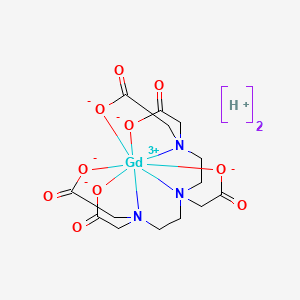Attribution Statement: LactMed is a registered trademark of the U.S. Department of Health and Human Services.
NCBI Bookshelf. A service of the National Library of Medicine, National Institutes of Health.
Drugs and Lactation Database (LactMed®) [Internet]. Bethesda (MD): National Institute of Child Health and Human Development; 2006-.
CASRN: 80529-93-7

Drug Levels and Effects
Summary of Use during Lactation
Amounts of gadolinium excreted into breastmilk after maternal gadopentetate are less than 1% of the amount allowed to be given to infants. In addition, because gadopentetate is poorly absorbed orally, it is not likely to reach the bloodstream of the infant or cause any adverse effects in breastfed infants. Gadopentetate has been associated with some cases of nephrogenic systemic fibrosis in patients with renal impairment. Guidelines developed by North American professional organizations state that breastfeeding need not be disrupted after a nursing mother receives a gadolinium-containing contrast medium.[1,2]
Drug Levels
Maternal Levels. A lactating woman who was weaning her infant (time postpartum not stated) was given an intravenous dose of 5.8 mmol (5.4 g) of gadopentetate dimeglumine which was equivalent to 0.1 mmol/kg. Samples of expressed breastmilk were obtained 6 times during the following 32.7 hours with the mother trying to completely empty the breasts at each time. Milk was analyzed for elemental gadolinium. The highest amount of gadolinium in milk of 5.1 micromoles/L was detected at 4.8 hours after the dose. At 22 hours after the dose, milk levels were less than 1 micromole/L. About 0.66 micromole (0.6 mg) of gadopentetate was excreted over the time of milk collection. This amounted to about 0.01% of the mother's total (not weight-adjusted) dose.[3]
A mother who was 13 weeks postpartum was given an intravenous dose of 7 mmol (6.6 g) of gadopentetate dimeglumine which was equivalent to 0.1 mmol/kg. Breastmilk was collected from each breast at 2, 11, 17 and 24 hours after the dose. Milk was analyzed for elemental gadolinium. The highest amounts in milk were in the 2-hour sample, having 2.8 and 3.4 micromoles/L (2.6 and 3.2 mg/L) in the milk from each breast respectively. At 11 hours, the values were 2.8 and 2.9 micromoles/L; by hour 17, the amounts in milk were at or below the detection limit of about 1 micromole/L. The authors estimated that 1.6 micromoles (1.5 mg) or 0.023% of the maternal dose (not weight-adjusted) would be excreted in the 24 hours after administration.[4]
Nineteen women received intravenous gadopentetate, in a dose of 0.1 mmol/kg (n = 18) or 0.2 mmol/kg (n = 1). The mothers withheld nursing for 24 hours and emptied both breasts completely at times chosen by the mother based on her own normal breastfeeding times. For the 18 subjects who received the lower dose, the average dose in milk was 5.9 mmol (range 4.8 to 7.4 mmol). The woman who received double the dose had milk gadolinium excretion in the same range as the others. Milk was analyzed for elemental gadolinium. The time of the peak gadolinium level in milk varied between 1 and 8 hours after the dose in 15 of the women; in 3 women, the peak values occurred at 9, 11 and 13 hours after the dose. The total amount excreted in milk averaged 0.57 micromole (range 0.052 to 3 micromoles). The average amount excreted was 0.009% of the administered dose (range 0.001 to 0.4%). The authors concluded that breastfed infants would ingest less than 1% of the usual maximal neonatal dose of 0.2 mmol/kg and that this dose would not warrant discontinuing breastfeeding after gadopentetate administration.[5]
Infant Levels. Relevant published information was not found as of the revision date.
Effects in Breastfed Infants
Relevant published information was not found as of the revision date.
Effects on Lactation and Breastmilk
Relevant published information was not found as of the revision date.
Alternate Drugs to Consider
References
- 1.
- Copel J, El-Sayed Y, Heine RP, et al. Committee Opinion No. 723: Guidelines for diagnostic imaging during pregnancy and lactation. Obstet Gynecol. 2017;130:e210–e216. [PubMed: 28937575]
- 2.
- American College of Radiology Committee on Drugs and Contrast Media. Administration of contrast media to breast-feeding mothers. In, ACR manual on contrast media. 2022;Version 2022:106-7. https://www
.acr.org/Clinical-Resources /Contrast-Manual. - 3.
- Schmiedl U, Maravilla KR, Gerlach R, et al. Excretion of gadopentetate dimeglumine in human breast milk. AJR. 1990;154:1305–6. [PubMed: 2110745]
- 4.
- Rofsky NM, Weinreb JC, Litt AW. Quantitative analysis of gadopentetate dimeglumine excreted in breast milk. J Magn Reson Imaging. 1993;3:131–2. [PubMed: 8428080]
- 5.
- Kubik-Huch RA, Gottstein NM, Frenzel T, et al. Gadopentetate dimeglumine excretion into human breast milk during lactation. Radiology. 2000;216:555–8. [PubMed: 10924585]
Substance Identification
Substance Name
Gadopentetate
CAS Registry Number
80529-93-7
Disclaimer: Information presented in this database is not meant as a substitute for professional judgment. You should consult your healthcare provider for breastfeeding advice related to your particular situation. The U.S. government does not warrant or assume any liability or responsibility for the accuracy or completeness of the information on this Site.
- User and Medical Advice Disclaimer
- Drugs and Lactation Database (LactMed) - Record Format
- LactMed - Database Creation and Peer Review Process
- Fact Sheet. Drugs and Lactation Database (LactMed)
- Drugs and Lactation Database (LactMed) - Glossary
- LactMed Selected References
- Drugs and Lactation Database (LactMed) - About Dietary Supplements
- Breastfeeding Links
- PubChem SubstanceRelated PubChem Substances
- PubMedLinks to PubMed
- Review Gadobenate.[Drugs and Lactation Database (...]Review Gadobenate.. Drugs and Lactation Database (LactMed®). 2006
- Review Ioxaglate.[Drugs and Lactation Database (...]Review Ioxaglate.. Drugs and Lactation Database (LactMed®). 2006
- Review Gadoxetate.[Drugs and Lactation Database (...]Review Gadoxetate.. Drugs and Lactation Database (LactMed®). 2006
- Review Gadofosveset.[Drugs and Lactation Database (...]Review Gadofosveset.. Drugs and Lactation Database (LactMed®). 2006
- Review Iopromide.[Drugs and Lactation Database (...]Review Iopromide.. Drugs and Lactation Database (LactMed®). 2006
- Gadopentetate - Drugs and Lactation Database (LactMed®)Gadopentetate - Drugs and Lactation Database (LactMed®)
Your browsing activity is empty.
Activity recording is turned off.
See more...
